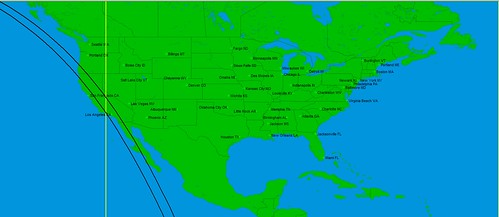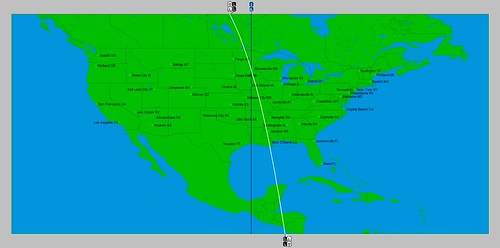The main planetary alignments are Mercury's retrograde station, the Jupiter-Uranus opposition, the Sun's conjunction with Mercury, and the direct station of Uranus. Mercury's retrograde station has been shown to increase wind velocities over the areas where Mercury appears in key weather charts. For example, between January 21st and 25th, 2015, Mercury held such a position over Southern California. The National Weather Service at that time warned the inhabitants of the area of locally gusty winds and strong damaging Santa Ana winds. (see post)
December 20-29, 2016
The Last Quarter Moon of December 20, 2016 will highlight the same area. The following astro-locality map shows three lines that represent the Moon's position (yellow line) and Mercury and Pluto's position (the two black lines - Mercury is the leftmost line). This intimates that between the 20th and 29th of December weather conditions over Southern California (and the West Coast states in general) could get quite blustery perhaps accompanied by rainy conditions.

December 26-30, 2016
On December 26th, Jupiter will oppose Uranus. In the parlance of astro-meteorology, this signifies high velocity winds, lower ranges of temperatures, and storm potential. The last Jupiter-Uranus opposition was on August 29, 2013. On this day, Fabian, churning east of the Lesser Antilles, became the season's third hurricane. Key charts placed Jupiter and Uranus over the western Atlantic as well as over the east-central and eastern US. Weekly rainfall totaled 2 to 6 inches from Missouri to the Mid-Atlantic states as Tropical Storm Grace became embedded in a nearly stationary front according to the Weekly Weather and Crop Bulletin.
This year, the Jupiter-Uranus opposition will affect the Central and Eastern Plains. As seen in the map below, an important planetary crossing forms with Jupiter, Uranus (white line), and Mercury (blue line) over Minnesota, Wisconsin, and Iowa where cold, gusty winds and storm conditions may pose threats.

December 28th brings the Sun's conjunction to Mercury which takes up residence over the Central Plains. To get an idea of the cold, stormy, and windy conditions generated by a Sun-Mercury conjunction check out this link. Something similar to that is indicated now.
December 29, 2016
The last planetary phenomenon to mention is the direct station of Uranus which affects the Pacific Northwest. This planet is known for its cold influence and wind-generating capabilities. Most of the aspects we're discussing in this post seem to major on this theme. To get an idea of what kind of weather the Pacific Northwest should expect refer to this link. The influence of Uranus' direct station requires a bit of a window in which its influence on the weather is felt. This should begin to manifest from the 29th through the first few days of January 2017.
Links to Other Long-range Weather Forecasts and Forecast Results
Hurricane Dolores Fulfills Long-range Weather Forecast
Hurricane Season 2015 Long-range Weather Predictions
Tropical Cyclone Hadi
Hurricane Erick Fulfills Long-range Forecast
Tropical Storm Andrea Fulfills Long-range Forecast!
Timing the Relief for Drought-Stricken U.S. Plains
Testing Astrometeorology Part 2
Hurricane Sandy Fulfills Long-range Weather Prediction!
Testing Astrometeorology Part 1
Hurricane Season 2011 Forecast Results
Hurricane Risk-Management
New Weather Alternative Website
Fulfilled Long-range Forecasts for Hurricane Season 2010
Introduction to the Weather Alternative
Some links to recent Climate Change articles
No comments:
Post a Comment